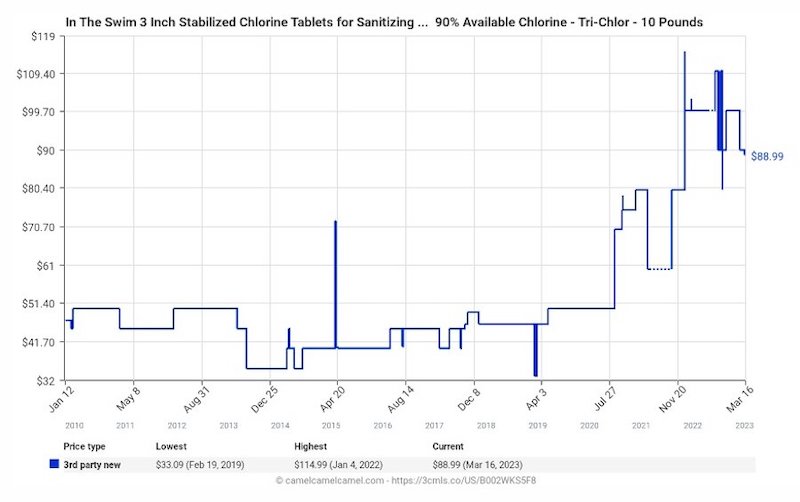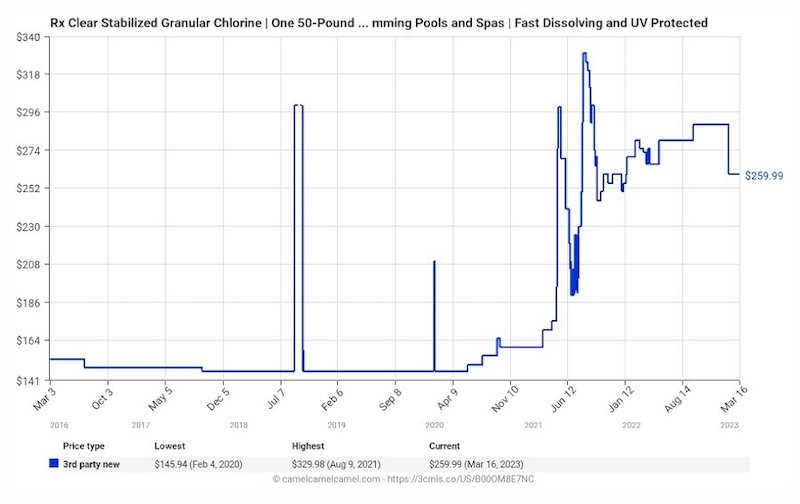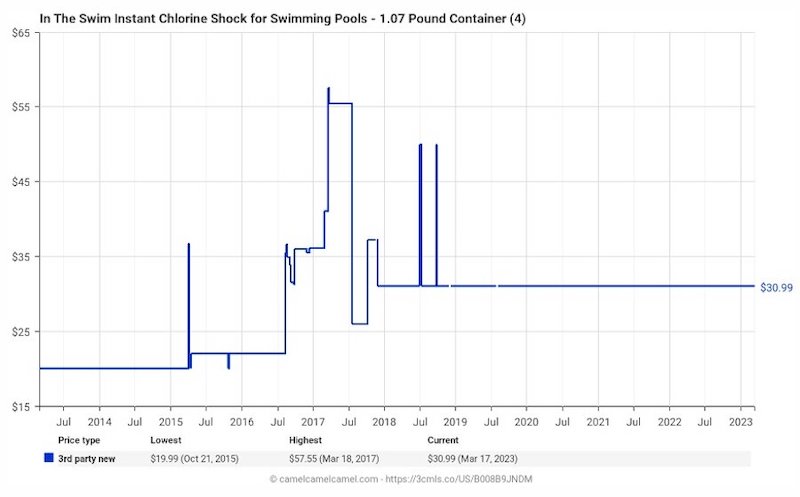It’s no secret the price of chlorine has gotten a little out of control lately.
But why is chlorine so expensive now? What caused the chlorine shortage? And what can you do to avoid paying a premium for your sanitizer?
Quick answer: The pandemic was the single biggest factor driving up the demand and price of pool chlorine, but there were also major supply issues and significant rising costs of production and transport.
Why is Pool Chlorine So Expensive Now?
Chlorine has always been considered among the cheapest swimming pool sanitizers on the market.
Ever since the pandemic, that’s no longer a given.
But while the spread of Covid-19 and subsequent lockdowns drove the demand for pool supplies through the roof, you might be surprised to know it wasn’t the only factor behind the rising cost of chlorine.
Another factor was a reduction of chlorine available on the market. This was largely a result of a fire in late 2020 that temporarily shut down the BioLab chemical plant in Louisiana, which was the second-largest producer of chlorine tablets in the US.
(Fortunately, the lab reopened in late 2022, with renovations that will allow even faster production than before. This is expected to alleviate some of the supply issues moving forward.)
Finally, it’s no secret inflation has been on a tear in recent years. In fact, the average inflation rate for 2022 was a whopping 8% in the United States.
When the cost of raw materials, production, and transport go up, it always makes its way to the consumer eventually.
In summary, it’s a combination of increased demand, decreased availability, and rising costs.
How Much More Expensive Is Chlorine Now?
In order to gauge how expensive chlorine has become, we looked at Amazon’s historical pricing data to see how it changed for popular chlorine products over time.
Let’s start with these 3-inch trichlor tablets from InTheSwim:

As you can see, the price stayed at around $45 for many years since it was listed in 2010, while never going above $51.40.
This all changed during the start of the pandemic in early 2020, forcing a sharp increase in price to just shy of $80. While this was followed by a temporary price drop in the winter of 2021, summer brought with it another huge spike that briefly took the product to well over $100.
As of today, the price is still around 2x pre-pandemic levels, and this is expected to rise further as we head into another pool season.
Let’s do another, shall we?
Here’s the chart for Rx Clear granular dichlor chlorine:

While this product hasn’t been listed on Amazon for as long, there’s certainly enough data here to draw a similar conclusion.
The product held at around $150 since it was listed in 2016, and while there was a brief unexplained spike in 2018, the price quickly dropped back down to where it was previously.
That was until, yet again, around April/March of 2020. This time we can see a slower ramp-up in price but it ultimately shoots above $318 during the height of the pandemic.
As before, we’re still looking at almost 2x the cost for this product compared to pre-pandemic despite currently being out of season.
How Can You Get Around the Chlorine Price Hike?
You still need to sanitize your pool, and chlorine is still considered widely considered the sanitizing agent of choice — so how can you do it without having to remortgage the house?
Well, you have two options:
Option #1: Switch to Unstabilized Chlorine
During our research, we found that stabilized chlorine products saw a much larger price increase compared to unstabilized chlorine, which only saw a minor increase on average.
This is likely due to stabilized chlorine being traditionally more popular among pool owners, which leads to more supply and demand issues. It’s also worth noting the BioLab that temporarily shut down produced stabilized chlorine.
Did you know? Stabilized chlorine includes most tablets and many granular forms of chlorine, as these often contain cyanuric acid (pool stabilizer). Sodium hypochlorite (liquid chlorine) is a good example of unstabilized chlorine.
To illustrate, here’s the historical pricing data for InTheSwim's liquid chlorine:

While the price of this product increased over time, most of that movement happened pre-pandemic. More importantly, this particular product wasn’t impacted at all by recent events.
Fortunately, unstabilized chlorine is a very viable alternative to sanitizing your pool water, and in many ways it’s actually better.
This is primarily because you add cyanuric separately, only when it’s needed. This prevents your water from becoming over-stabilized, locking up your chlorine, and forcing you to drain a significant amount of water in order to fix it.
Periodically adding liquid chlorine to your water is a more manual process, however, so you won’t be able to set and forget like you can with chlorine tablets.
If you want a more detailed breakdown, we wrote an entire article comparing liquid chlorine to chlorine tablets.
Option #2: Convert to a Saltwater System
Moving to a salt system has always been a popular alternative to using traditional chlorine products, but now even more so.
A salt generator converts salt to chlorine on an ongoing basis, so even though you’ll still technically have a chlorine pool, it completely eliminates the need for chlorine tablets, granules, or even liquid chlorine.
The biggest benefit of this approach is that manually dosing your pool becomes a thing of the past. As long as there’s enough salt content in the pool, the pool is largely self-maintained when it comes to chlorination.
But the cost-savings shouldn’t be ignored either.
While there is a significant upfront cost to converting a traditional chlorine pool to a saltwater pool, it often pays for itself within 3-5 years as the cost of salt is significantly cheaper than buying chlorine off the shelf.
Before the pandemic, it was arguable whether the potential savings were significant enough to justify switching over. Now, with many chlorine brands more than doubling in price, it’s hardly up for debate.
If you can afford to install a salt generator into your pool setup, it might be worth some serious consideration.
What About Reducing Chlorine Usage?
Yes, there are ways to reduce how much chlorine your water needs and these can certainly alleviate some of the stress on your wallet.
The basic things to look at are:
- Keeping your pH level and total alkalinity balanced at all times
- Using cyanuric acid to prevent the sun burning off your chlorine too quickly
- Using a pool cover to limit the amount of sun exposure your water gets
- Shocking your pool regularly to oxidize used chlorine in the water
- Ensuring proper circulation to better distribute your chlorine
- Ensuring proper filtration to take reduce the amount of debris in the water
All of these steps are considered good pool maintenance regardless of how they impact chlorine consumption, but doing as many of these as possible will inevitably reduce the need for more chlorine.
Aside from the basics, there are more intentional ways to reduce chlorine usage in your pool, such as using a mineral system or UV system.
However, while these systems do assist chlorine in dealing with contaminants in the water, the savings in chlorine usage doesn’t always offset the cost of installing and maintaining these systems.
Overall, if you’re going to invest in something like that, you need to run the numbers to make sure it makes sense financially.
The New Normal
Despite the pandemic being a major factor in the rising cost of chlorine, there’s still no sign of prices returning to what they once were.
If the days of cheap stabilized chlorine are behind us, and current prices are to be considered normal from here on out, it might be time to switch things up in your maintenance routine.
